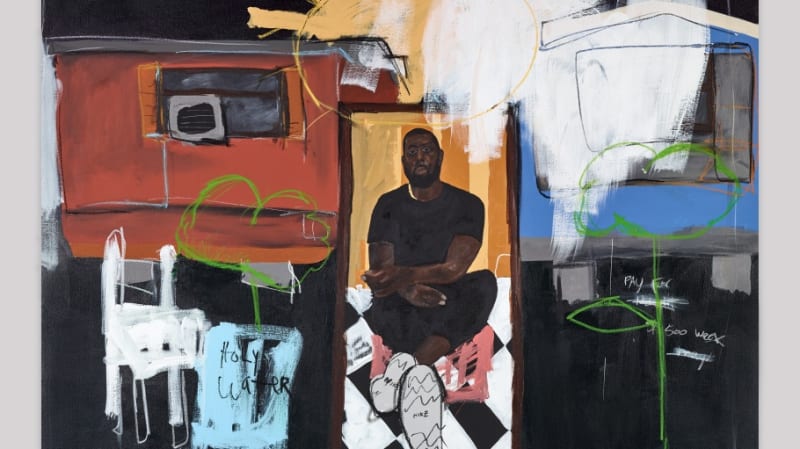BY KRISTEN TAUER
Jammie Holmes knows a painting is complete once he’s added the eyes. Facial expressions are the last thing he adds to his canvases when he’s painting a person. Holmes runs what he calls a “sound check” on each of his paintings once he’s finished. He listens to the painting — figuratively — to hear what it’s saying. But what it’s saying often comes down to the eyes. “When I look at the eyes of a person, that tells everything. I put the eyes in last because that’s when I feel like I’m giving it a heart,” he says.
The Dallas-based artist is self-taught, and the subjects of his works are rooted in his experience growing up in Southeast Louisiana on the Mississippi Delta. He paints poignant scenes of the Black community, family, childhood, and tradition. The works often contain artifacts from his youth — a box fan, a toy gun, the Nike swoosh — as well as scrawled numbers and words. Often, the image or text is partially obscured or crossed out. Viewable or not, the presence of whatever is difficult to see is still there.
“All my paintings are about myself growing up and being a young Black individual in America,” says Holmes, who often incorporates elements of childhood play, expressed through body or objects. “A lot of my figures have a worn look on their face, because I want people to realize how much of a struggle it can be,” he adds. “And not only that, growing up the way I grew up, by the time you make it this far, you’re exhausted because you felt like we had to do so much to get here.”
When the subject he’s mining is himself, the process of creation takes a particular emotional toll.
“Self-portraits drain the life out of me because I’m opening doors; none of my wounds turned into scars,” he adds “I have to look myself in the eyes. It’s really emotional, because I remember where I came from, and I look at where I’m at right now. Sometimes it’s just like, damn, how did I get this far in life, period.”
Holmes is newly represented by Library Street Collective, and he credits the Detroit-based gallery with providing him with the support to push his practice further. “They support and stand by me, no matter what,” says Holmes. “Like, ‘whatever you want to do. Let’s try to make it happen.’ That backing is letting my creativity grow large. I can paint large-scale paintings because now I have access to collectors that have walls big enough for these pieces. Working with Library Street opened the doors to a bigger canvas.”
He visited Detroit for the first time in late June, a few weeks after his multi-city aerial art performance piece “They’re Going to Kill Me.” On May 30, the artist flew aerial banners across the skies of five U.S. cities with George Floyd’s final words: “My Neck Hurts” in Dallas; “Please I Can’t Breathe” in Detroit. Afterward, Library Street Collective installed digital video installations of those performances in The Belt, an art-centric alley in downtown Detroit.
The Belt was also the canvas for his first public mural, painted during his visit. The process was daunting, but illuminating; Holmes is used to working inside a studio and having time and quiet to reflect one-on-one with the emotional message of his work.
“I call it sound checking my art,” he says. “Sometimes if you look at [the work] long enough, your brain is going to bring up a memory,” he adds. “I like to listen for those moments to make sure that I’m 100 percent complete with it. But when I’m outside, I can’t. I can’t stop traffic. I can’t stop people from coming around.” Painting in public presented a new form of a sound check. Holmes was able to interact with the memories his mural — depicting a young Black boy playing outside, mid backflip over an old discarded mattress — stirred up for the people walking by as he worked.
The artist recently contributed to Library Street Collective’s charitable platform Alliance, which auctions a single piece of artwork over the span of five days to benefit a charity of that artist’s choice. Holmes selected Empowerment Plan, which provides workplace development programs and support services for parents in homeless shelters. He painted a new work, “Box Fan Heroes #2,” for the occasion.
“I wanted to show myself at that moment of my life, to show people that this is where I come from also,” says Holmes of the painting. “If we had programs like the Empowerment Plan in the city I grew up in, I guarantee things would have been a little different growing up.”
Holmes will also exhibit a body of his work for the first time later this month with the launch of Library Street Collective’s new online platform Anatomy. The platform will give viewers an intimate look into an artist’s practice, zooming in on details of the work. The exhibition will feature all-new paintings. “I don’t like to show pieces I already showed,” he says. “Everybody deserves something new.”
While Holmes’ work is primarily within the genre of painting, he isn’t wedded to the medium. The attention from his recent public aerial artworks and related video works show a potential to speak to a wider audience outside of the art world. Art is expected in a gallery setting; it’s unexpected when flown through the sky in a space commonly reserved for words of celebration.
“When you see something like this, you stop and you stare. It it connected with the masses around the world. That definitely showed me that artists are the voice for the people,” he says of reaction to his aerial piece. “It showed how much power artists actually do have.
Now it’s just up to viewers to listen.


